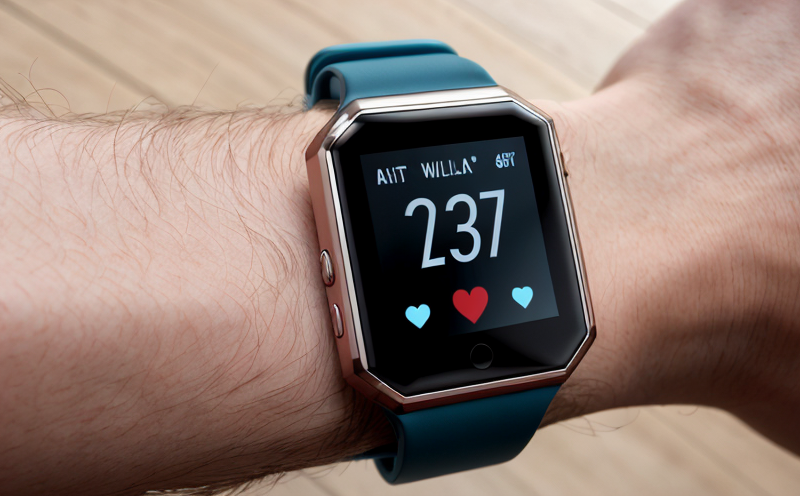IEC 60068-2-14 Thermal Shock Testing for Wearable Devices
Thermal shock testing is a critical procedure in the development and certification of wearable devices, ensuring that these innovative products perform reliably across a wide range of environmental conditions. This test evaluates how well wearables withstand sudden changes in temperature, which can be crucial for their performance and longevity.
The IEC 60068-2-14 standard specifies the procedures for conducting thermal shock testing on electrical and electronic equipment, including wearable devices. This method is designed to simulate real-world conditions where wearables are subjected to rapid temperature changes, such as being exposed to direct sunlight followed by cold environments or vice versa.
During this test, specimens undergo cycles of heating and cooling at controlled rates and temperatures. The goal is to assess the device's ability to withstand these extreme environmental conditions without failing or compromising its functionality. This testing is particularly important for ensuring that wearable devices are robust enough to meet the demands of various user environments.
The test setup typically involves a chamber capable of rapid temperature changes, with precise control over heating and cooling rates. The specimen is placed in this chamber, where it undergoes cycles of temperature variations. The testing process often includes multiple cycles, each consisting of a defined period at high temperatures followed by a similar duration at low temperatures.
The acceptance criteria for IEC 60068-2-14 thermal shock testing are based on the device's ability to maintain its performance and integrity throughout the test. The standard provides specific guidelines for temperature ranges, cycle durations, and the number of cycles required to meet regulatory compliance. Compliance with these standards ensures that wearable devices can be trusted in various environments.
Key Considerations
- Environmental Factors: Understanding how different environmental factors affect wearables is crucial for ensuring they perform consistently across diverse climates.
- User Needs: Tailoring the testing process to meet specific user needs, such as those in extreme weather conditions or high-temperature environments.
- Data Collection: Collecting accurate data during and after testing to ensure that the device meets all required specifications.
Benefits
Conducting IEC 60068-2-14 thermal shock testing offers numerous benefits for manufacturers of wearable devices. Compliance with this standard ensures that products are robust and reliable, enhancing consumer trust and satisfaction.
The test helps identify potential weaknesses in the design or manufacturing process before the product reaches the market. This early detection allows for necessary adjustments to be made, improving the overall quality of the device. Additionally, passing thermal shock testing demonstrates compliance with international standards, which is essential for regulatory approval and market entry.
Thermal shock testing also contributes to the longevity of wearables by ensuring that they can withstand a wide range of environmental conditions. This durability not only extends product life but also reduces maintenance costs and enhances user experience.
Furthermore, compliance with IEC 60068-2-14 helps manufacturers differentiate their products in competitive markets. Demonstrating adherence to international standards can be a key selling point for consumers looking for high-quality, reliable devices.
Industry Applications
| Application Area | Description |
|---|---|
| Outdoor Sports Wearables | Testing ensures devices can withstand extreme temperature changes during outdoor activities. |
| Medical Monitoring Devices | Validation of wearable medical devices in varying environmental conditions is critical for patient safety. |
| Wearable Fitness Trackers | Ensuring robust performance under diverse temperature conditions enhances user experience and satisfaction. |
The IEC 60068-2-14 standard is widely applied in the medical device testing sector, particularly for wearable devices used in monitoring patient health. This ensures that these devices can provide accurate readings under a variety of environmental conditions.
Competitive Advantage and Market Impact
- Regulatory Compliance: Ensures adherence to international standards, facilitating market entry in multiple regions.
- Enhanced Quality: Identifies potential issues early, leading to improved product quality.
- Customer Trust: Builds confidence among consumers by demonstrating a commitment to product reliability and safety.
The implementation of IEC 60068-2-14 thermal shock testing provides significant competitive advantages in the medical device industry. By ensuring that wearable devices meet stringent international standards, manufacturers can differentiate their products from competitors. This not only enhances market position but also leads to increased customer satisfaction and loyalty.
Moreover, compliance with these standards helps companies navigate complex regulatory landscapes, reducing the risk of non-compliance penalties and ensuring a smoother product launch process.





